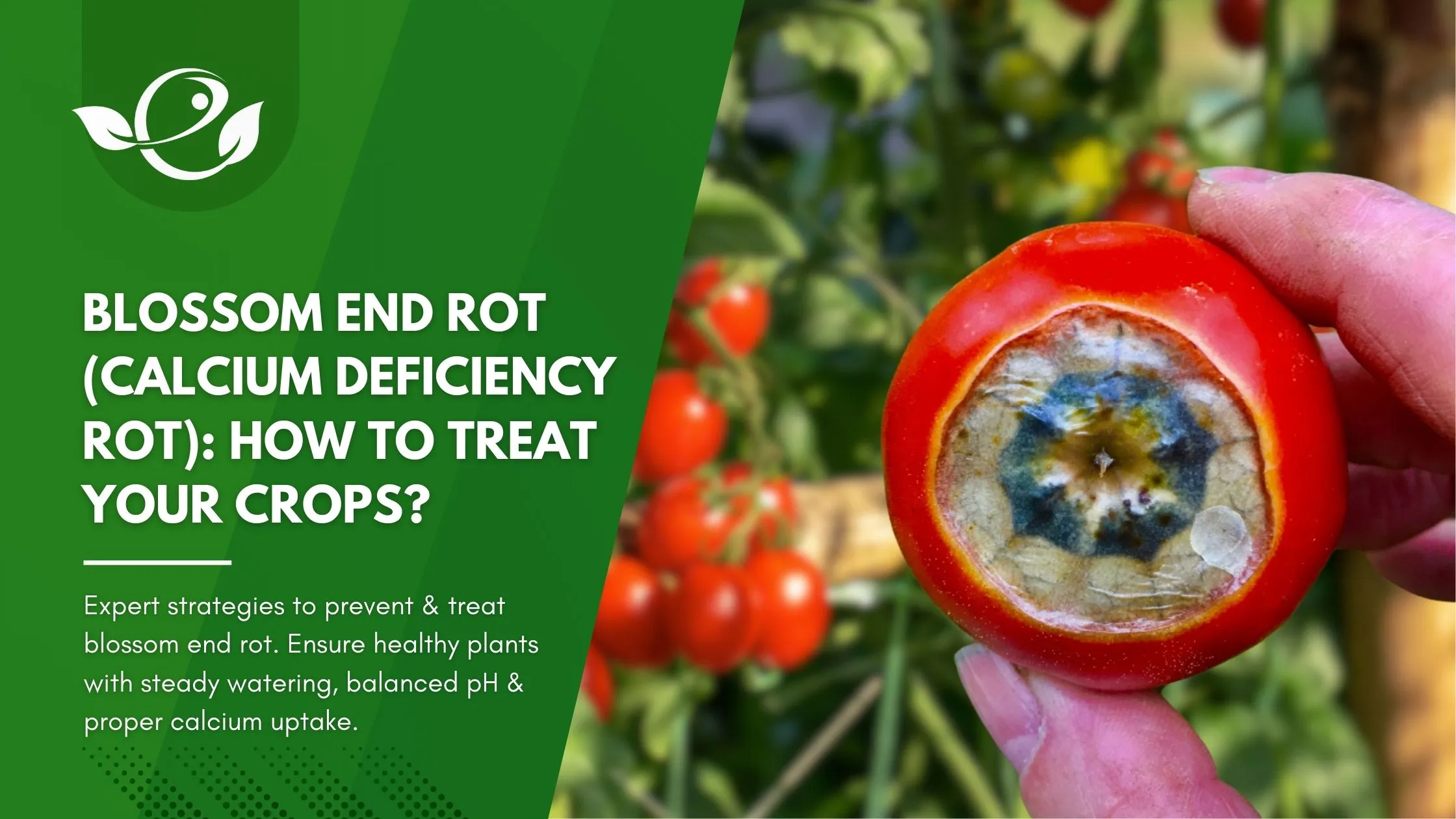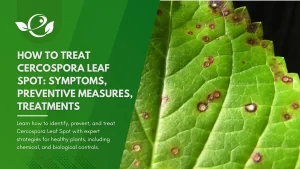Table of Contents
Imagine nurturing your garden with tender care—watering diligently, amending the soil with organic compost, and watching your plants thrive. Then, just as the first plump fruits begin to form, you notice an unmistakable blemish: a dark, sunken spot at the blossom end of your tomato or pepper. This is blossom end rot, a common yet frustrating disorder that can undermine even your most carefully tended crops. Although it may appear alarming, blossom end rot isn’t a contagious disease but rather a symptom of disrupted calcium transport within the plant.
In this article, we’ll explore the intricate causes behind blossom end rot—from erratic watering and rapid fruit growth to soil pH imbalances and excessive nitrogen levels—and provide expert strategies for treatment and prevention. Whether you’re a seasoned gardener or a dedicated home grower, understanding the underlying science of this disorder will empower you to make informed decisions, protect your crops, and ultimately enjoy a more bountiful, healthy harvest.
What is Blossom End Rot?
Blossom end rot (BER) is not a contagious disease but a localized disorder resulting primarily from a calcium deficiency at the fruit’s distal end—the part opposite the stem. This deficiency leads to cell collapse and degradation, eventually manifesting as dark, sunken spots that start as water-soaked lesions and progress to dry, leathery decay. Although the soil may contain sufficient calcium overall, the key problem often lies in inadequate transport of calcium to developing fruits due to inconsistent watering or other environmental stresses.
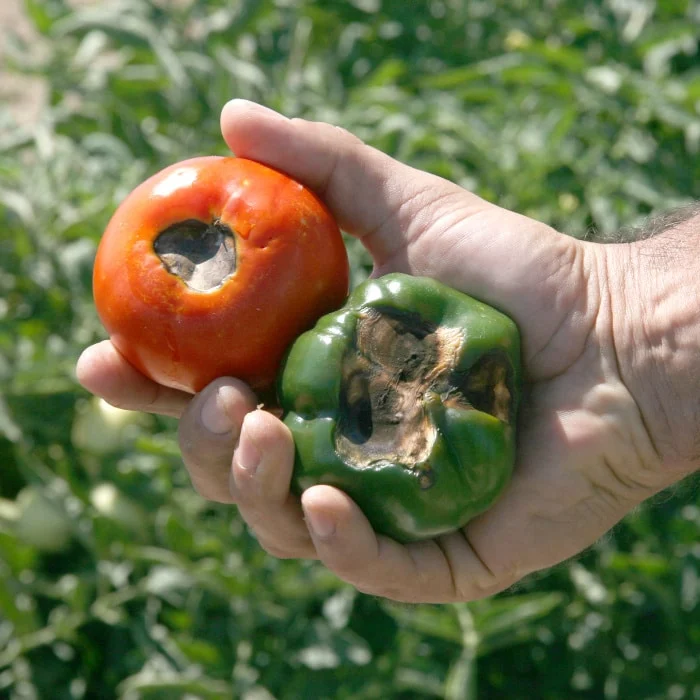
“Calcium deficiency in the fruit tissues—rather than a lack of calcium in the soil per se—is the central factor in Blossom End Rot. The disorder develops when rapid fruit growth coincides with suboptimal water uptake, hindering calcium translocation.”
Commonly Affected Plants
- Bitter Gourd
- Cucumber
- Melon
- Capscum and Chilli
- Pumpkin
- Tomato
- Zucchini
Causes of Blossom End Rot
Several factors contribute to the occurrence of blossom end rot. Understanding these causes is essential for both treatment and prevention:
1. Inadequate Calcium Uptake
- Primary Issue: Although many soils contain ample calcium, its uptake is closely tied to water movement in plants. When water is scarce or unevenly distributed, calcium is unable to reach the fruit tissues adequately.
- Transpirational Flow: Calcium is moved only through the xylem along with water, making areas with low transpiration, such as rapidly growing fruits—particularly susceptible to deficiencies.
2. Irregular Watering Practices
- Fluctuating Soil Moisture: Periods of drought stress, followed by heavy watering, create cycles that inhibit smooth calcium transport.
- Environmental Stress: Prolonged hot or cool periods and inconsistent irrigation interfere with optimal water uptake.
3. Soil pH and Nutrient Imbalances
- Acidic or Alkaline Soils: Suboptimal pH levels (ideally between 6.5 and 7.0) can bind calcium into forms less available for plant uptake.
- Excess Nitrogen: Over-fertilization—particularly with high-nitrogen fertilizers—can accelerate leafy growth, diverting calcium away from the fruits and worsening Blossom End Rot symptoms.
“Factors such as uneven watering, root damage from cultivation, and imbalanced soil pH interact with high nitrogen levels to significantly restrict calcium transport to fruit tissues.”
How To Identify Blossom End Rot
Accurately diagnosing blossom end rot is the first step toward effective management. By carefully examining your fruits and understanding the progression of the disorder, you can quickly implement corrective measures. Here’s an in-depth look at the visual and diagnostic features of blossom end rot:
Visual Characteristics and Early Signs
- Initial Lesions: The first symptom of blossom end rot is a small, water-soaked spot that appears at the blossom end of the fruit (the end opposite the stem). These spots are typically circular and may range in diameter from about 0.5 to 1 centimetre. In the early stage, the lesion often has a pale or greyish appearance before it darkens.
- Progression and Color Changes: As the condition worsens, the water-soaked spot enlarges and its colour changes from light brown to deep, almost black. The tissue loses moisture, becoming hard, dry, and leathery. The contrast between the healthy, vibrant tissue and the sunken, discoloured area is a key indicator of blossom end rot.
- Localised Occurrence: Blossom end rot tends to affect only the blossom end of the fruit. Unlike systemic diseases, the discolouration does not spread across the entire fruit; other areas remain healthy and show normal growth.
- Internal Damage: In more advanced cases, if you cut open an affected fruit, you may notice that the internal tissues near the blossom end are also discoloured or necrotic. This internal browning underscores the irreversible nature of the damage once established.
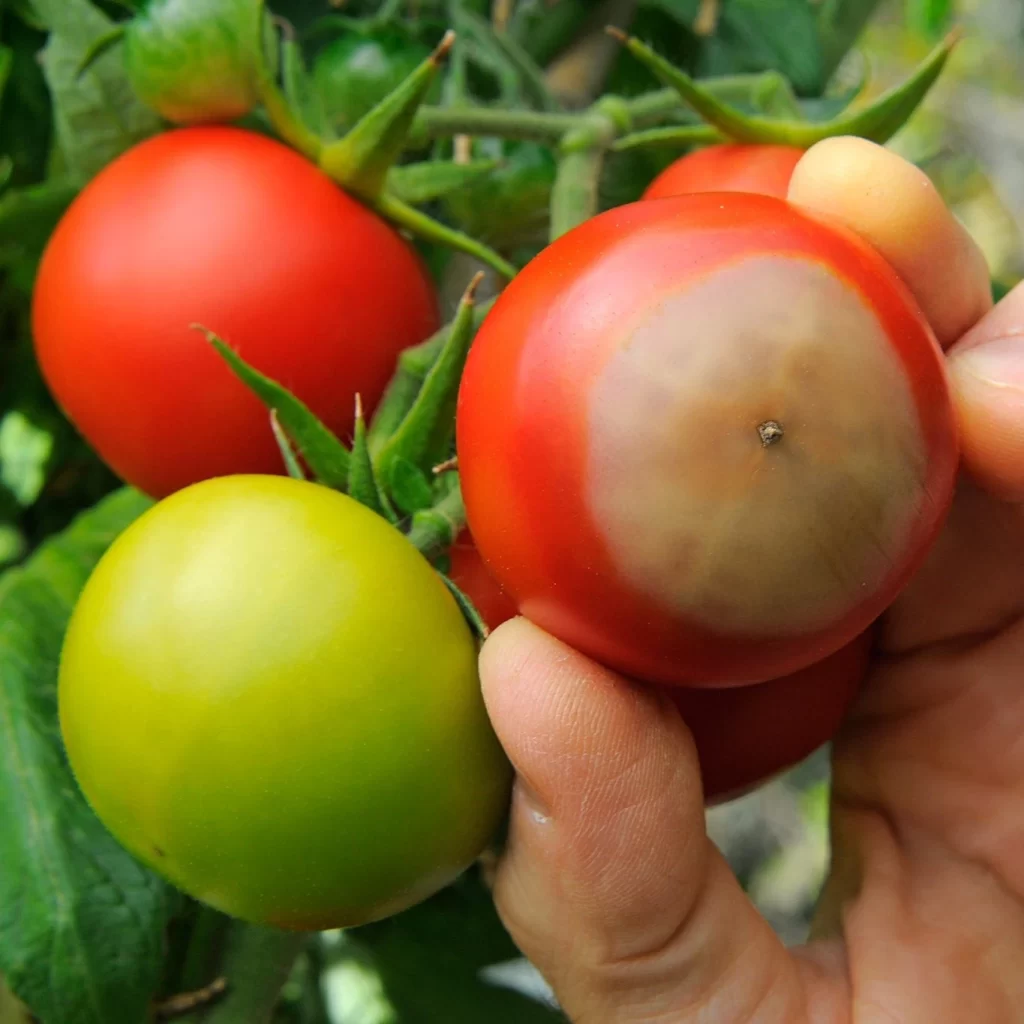
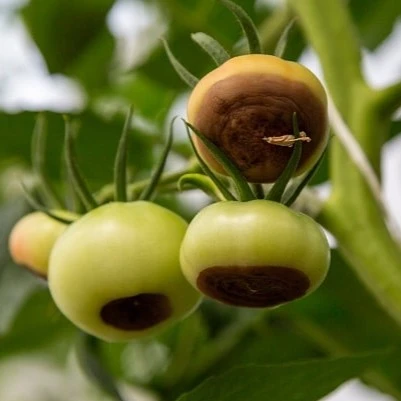
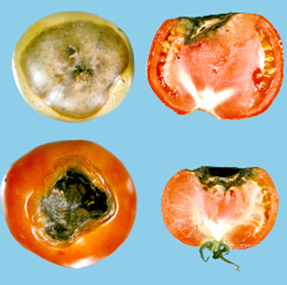
Development Patterns
- Timing During Growth: Blossom End Rot is most commonly seen on the very first fruits of the season. During rapid early growth, plants may not supply enough calcium to meet the high demand, making young fruits particularly vulnerable. Environmental stresses at this critical time can compound the problem.
- Distribution on a Plant: Not all fruits on a plant will show symptoms. Often, only a few fruits—typically those on the lower or outer portions of a cluster—exhibit signs of blossom end rot, while others may develop normally. This patchy distribution can help differentiate Blossom End Rot from systemic issues like fungal infections.
- Spot Boundaries and Shape: The affected area usually has a clear boundary that contrasts sharply with the surrounding healthy tissue. In some cases, however, the transition may be less defined if the condition has advanced over time.
“Blossom end rot is best identified by its localized, circular lesions that begin as water-soaked spots at the blossom end. When these lesions darken and become sunken, it is a clear sign that inadequate calcium transport—often due to irregular watering—is at play.”
How To Treat Blossom End Rot
When your fruit exhibits signs of blossom end rot, the primary goal is to stop further damage while adjusting cultural practices to ensure healthier fruit development in the future. Although affected fruits cannot be restored, the following steps can help correct the underlying issues and protect subsequent fruit.
Immediate Actions
- Remove Affected Fruits:
Once Blossom End Rot manifests, promptly remove the discoloured fruits from the plant. This not only prevents the plant from wasting resources on compromised produce but also avoids secondary infections. Discarding affected fruit ensures that energy is redirected to healthy fruit formation. - Inspect the Plant:
Examine the foliage and stem bases for any signs of associated stress or damage. Although Blossom End Rot is not contagious, damaged roots or concurrent pest issues may compound the problem. A thorough inspection helps verify that the problem is isolated to nutritional and water management deficiencies.
Enhancing Calcium Uptake
Correcting the underlying calcium deficiency is essential because even with sufficient calcium in the soil, the transport to fruit tissues can be impaired. Addressing the factors that limit calcium uptake can significantly help reduce Blossom End Rot incidence.
- Optimise Watering Practices:
- Consistent Irrigation:
Ensure the plant receives a steady supply of water. Using drip irrigation or soaker hoses provides even moisture distribution, reducing fluctuations in soil moisture that hinder the transport of calcium via the xylem. - Deep, Infrequent Watering vs. Shallow Watering:
Water deeply to encourage a robust root system rather than applying frequent, light watering, which often leads to rapid surface drying. Consistent deep watering helps maintain an uninterrupted transpiration stream essential for moving calcium to the developing fruit.
- Consistent Irrigation:
- Amend the Soil for Improved Calcium Availability:
- Calcium-Based Fertilizers:
Amend the soil with products such as gypsum (calcium sulfate), lime (calcium carbonate), or bone meal. Gypsum offers a fast-acting calcium boost without significantly altering soil pH, making it ideal when the pH is already within the optimal range. Lime can be effective for acidic soils by neutralizing pH while slowly releasing calcium. Bone meal not only supplies calcium but also adds phosphorus, though its release is more gradual. - Supplementary Organic Matter:
Incorporating well-decomposed compost enriches soil structure and increases its water-holding capacity, both critical for sustained nutrient uptake. Organic matter also encourages beneficial microbial activity, which can aid in nutrient solubilization and availability.
- Calcium-Based Fertilizers:
- Employ Foliar Calcium Sprays:
Foliar applications using a calcium nitrate or calcium chloride solution can provide an immediate, albeit temporary, relief by supplying a direct source of calcium to the plant tissues. However, the efficacy of foliar sprays is limited by the fact that calcium, once incorporated in the mature leaf tissue, is not easily translocated. Therefore, use these sprays as a complement, not a substitute—for comprehensive soil and watering management.
Apply calcium-rich substances such as algal limestone, basalt flour, burnt lime, dolomite, gypsum and slag lime to the soil.
Note: Research indicates that while foliar sprays may help “green up” young tissues, they should be applied under cool conditions to avoid leaf burn and maximize absorption.
Preventive Measures of Blossom End Rot

Sustainable management strategies are crucial to mitigate the risk of blossom end rot in future crops.
- Soil Testing and pH Management:
Regular soil tests determine not only nutrient levels but also the pH, which significantly influences calcium availability. Maintain the soil pH between 6.5 and 7.0. Adjust pH as needed using appropriate amendments (lime to raise pH or sulfur to lower it). “A consistent soil pH ensures that calcium remains in a soluble, plant-accessible form, preventing the localized deficiencies seen in Blossom End Rot.” - Balanced Fertilization:
Avoid over-fertilization, particularly with high-nitrogen formulas. Excess nitrogen promotes rapid vegetative growth, drawing calcium away from developing fruit. Instead, use balanced fertilizers that provide moderate levels of nitrogen while emphasizing phosphorus and potassium. These formulations support overall plant health without compromising calcium allocation. - Mulching:
Apply an organic mulch layer (such as straw, chopped leaves, or wood chips) around the base of the plants. Mulching helps retain soil moisture, regulate temperature, and reduce water evaporation. With a more constant moisture level, plants maintain a steady transpirational flow, which is vital for calcium movement. - Improving Root Health:
Minimize root disturbance by reducing aggressive tilling or digging close to the plants. Healthy, undamaged roots have enhanced capacity to absorb water and nutrients. Additionally, ensure good plant spacing to prevent competition among roots, allowing for effective nutrient acquisition. - Use nitrate forms of nitrogen rather than ammonium. [1]
Frequently Asked Questions (FAQs)
Can blossom end rot be reversed once it appears?
No, the affected fruit cannot be recovered. The focus should be on preventive strategies for future fruit development.
Is foliar calcium spray effective?
Foliar sprays can supply a temporary calcium boost; however, they do not address the underlying issue of insufficient calcium transport caused by inconsistent watering. They are best used as a supplement to sound soil management practices.
What role does soil pH play in preventing Blossom End Rot?
Optimal soil pH (6.5–7.0) enhances calcium availability to plants. Soil that is too acidic or alkaline can reduce the solubility and uptake of calcium, increasing the risk of blossom end rot.
What are the best organic methods for managing blossom end rot?
Organic amendments such as gypsum or finely ground eggshells (properly pulverized to speed up breakdown) can be used as a gentle, slow-release calcium source. Additionally, maintaining a consistent mulching routine prevents soil moisture fluctuations and preserves the integrity of the root zone—all crucial for balanced nutrient uptake.
Are there tomato varieties that are naturally more resistant to blossom end rot?
Yes, some tomato varieties tend to be less susceptible to blossom end rot. Cherry tomatoes, for example, are often more resilient because their smaller fruits require a lower total amount of calcium compared to larger plum or beefsteak varieties
Conclusion
Blossom end rot is a multifaceted disorder primarily linked to calcium transport issues exacerbated by inconsistent watering, environmental stress, and soil nutrient imbalances. While it cannot be reversed once fruit are affected, its impact on your crop can be significantly minimized by adopting a consistent watering regimen, conducting regular soil tests, applying appropriate calcium amendments, and practicing good crop management techniques. With the right preventive measures in place, gardeners and growers can reduce the incidence of blossom end rot and enjoy a more bountiful, healthy harvest.
Have you encountered blossom end rot in your garden? Share your experiences and tips in the comments below.
